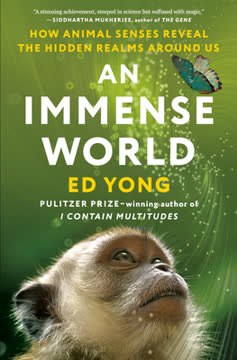Key Takeaways
1. Vision is universal yet diverse: Animals see the world in vastly different ways
"We cannot sense the faint electric fields that sharks and platypuses can. We are not privy to the magnetic fields that robins and sea turtles detect. We can't trace the invisible trail of a swimming fish the way a seal can. We can't feel the air currents created by a buzzing fly the way a wandering spider does."
Universal yet varied. Vision is a fundamental sense shared by countless species, yet its manifestations are incredibly diverse. Animals have evolved eyes suited to their specific needs and environments, resulting in a wide array of visual capabilities.
- Examples of unique visual abilities:
- Sharks and platypuses detecting electric fields
- Robins and sea turtles sensing magnetic fields
- Seals tracing invisible trails of swimming fish
- Wandering spiders feeling air currents from buzzing flies
This diversity in sensory perception reminds us that our human view of the world is just one of many possible perspectives. Understanding and appreciating these differences can broaden our comprehension of the natural world and the amazing adaptations that have evolved within it.
2. Unique eye structures: From scallops to jumping spiders, nature's ingenious designs
"Scallops have eyes arrayed along its inner edge—dozens in some species, and up to 200 in others. In the bay scallop, the eyes look like neon blueberries."
Nature's ingenious designs. The animal kingdom showcases an incredible variety of eye structures, each adapted to its owner's specific needs and environment. This diversity demonstrates the power of evolution in solving visual challenges in unique ways.
Examples of remarkable eye structures:
- Scallops: Up to 200 eyes along their shell edge, resembling neon blueberries
- Jumping spiders: Eight eyes arranged for near-360° vision
- Chameleons: Independently moving eyes for simultaneous multidirectional sight
- Streetsia challengeri (deep-sea crustacean): Single horizontal cylindrical eye for near-360° circumferential vision
These extraordinary designs challenge our preconceptions about what constitutes an "eye" and remind us of the endless possibilities that evolution can produce. By studying these diverse structures, we gain insights into the varied ways that animals perceive and interact with their environments.
3. The power of acute vision: Human eyesight's exceptional sharpness
"Humans outshine almost every other animal at resolving detail. Our exceptionally sharp vision, Melin realized, gives us a rarefied view of a zebra's stripes."
Human visual acuity. Contrary to popular belief, human vision excels in resolving fine details compared to most other animals. This exceptional acuity has significant implications for how we perceive and interact with our environment.
Key points about human visual acuity:
- Measured in cycles per degree (cpd), humans can distinguish 60-70 cpd
- Only birds of prey, like eagles, surpass human visual acuity
- Most animals, including many predators, have significantly lower acuity
- Lions: 13 cpd (legally blind by human standards)
- Honeybees: 1 cpd
This sharp vision has shaped human evolution and culture, enabling activities like reading, facial recognition, and fine motor skills. However, it can also lead to misunderstandings about how other animals perceive the world, as we tend to assume they see the same level of detail we do.
4. Beyond the human perspective: Appreciating diverse visual fields and acuities
"The human visual world is in front and humans move into it," Martin once wrote. But "the avian world is around and birds move through it."
Diverse perspectives. Animals possess a wide range of visual fields and acuities, often vastly different from the human experience. Understanding these differences is crucial for appreciating how various species perceive and interact with their environments.
Examples of diverse visual fields and acuities:
- Birds: Many have side-facing eyes with panoramic vision
- Mallard ducks: Can see the entire sky without moving
- Herons: Can see fish at their feet while standing upright
- Cows and other grazing animals: Horizontal stripe of acute vision for scanning the horizon
- Deep-sea fish: Tubular eyes for looking upward to spot silhouettes
- Chameleons: Independent eye movement for simultaneous multidirectional vision
These varied visual capabilities demonstrate how evolution has shaped each species' perception to suit its specific needs and environment. Recognizing these differences can help us better understand animal behavior and avoid misinterpreting their actions based on our human-centric perspective.
5. Speed of sight: How some animals perceive time differently through vision
"To its eyes, a human movie would look like a slideshow. The fastest of our actions would seem languid. An open palm, moving with lethal intent, would be easily dodged. Boxing would look like tai chi."
Temporal perception. The speed at which animals process visual information varies widely, leading to drastically different perceptions of time and motion. This variation in visual processing speed has significant implications for how different species interact with their environment and each other.
Factors affecting visual processing speed:
- Critical flicker-fusion frequency (CFF): The point at which flickering light appears continuous
- Size and speed of the animal: Smaller, faster animals tend to have higher CFFs
Examples of visual processing speeds:
- Humans: 60 Hz
- Dogs: 75 Hz
- Pied flycatcher (fastest vertebrate tested): 146 Hz
- Killer flies: Possibly over 350 Hz
These differences in visual processing speed can give certain animals significant advantages in activities like hunting or evading predators. Understanding these variations helps explain behaviors that might seem inexplicable from a human perspective, such as a fly's ability to dodge a swatting hand.
6. Nocturnal vision: Adaptations for seeing in extreme darkness
"Warrant has filmed the bee finding its nest on nights so dark that he couldn't even see his own hand in front of his face. He had to use night-vision goggles to see what the bee could with its own eyes."
Darkness adaptations. Many animals have evolved remarkable adaptations for seeing in extremely low-light conditions, challenging our assumptions about the limits of vision in darkness.
Examples of nocturnal vision adaptations:
- Megalopta genalis (sweat bee): Navigates through dense rainforest at night
- Uses neural tricks to enhance light sensitivity
- Pools responses from multiple photoreceptors
- Extends photon collection time
- Cats and deer: Possess a reflective tapetum behind the retina
- Tawny owls and tarsiers: Evolved exceptionally large eyes
These adaptations demonstrate nature's ingenuity in overcoming the challenges of darkness. They also remind us that the visual capabilities of many animals far exceed our own, especially in low-light conditions. Understanding these adaptations can provide insights into the diverse ways animals navigate and survive in their environments.
7. Deep-sea vision: Giant squid's enormous eyes and their evolutionary purpose
"With the largest and most sensitive eyes that exist, they scan one of the darkest environments on Earth for the faint sparkling outlines of charging whales."
Evolutionary purpose. The giant squid's enormous eyes, up to 10.6 inches in diameter, represent a unique adaptation to the challenges of deep-sea life. Their size and sensitivity serve a specific evolutionary purpose in this extreme environment.
Key points about giant squid eyes:
- Largest eyes in the animal kingdom, far exceeding those of other deep-sea creatures
- Evolved to detect large, bioluminescent objects in extreme depths
- Primary function: Spotting approaching sperm whales, their main predators
- Can detect bioluminescent clouds caused by whales from 130 yards away
This extraordinary adaptation highlights the evolutionary arms race between predator and prey in the deep ocean. It also demonstrates how specific environmental pressures can lead to the development of seemingly extreme characteristics. The giant squid's eyes serve as a testament to the power of natural selection in shaping unique solutions to survival challenges.
8. Color vision in dim light: Challenging previous assumptions about night vision
"At light levels equivalent to a half-moon, Kelber's world turned black and white, but the hawkmoths could still distinguish blue from yellow."
Nocturnal color vision. Contrary to long-held beliefs, some animals possess the ability to see colors in very dim light conditions. This discovery challenges our understanding of night vision and opens up new questions about the evolution and function of color perception.
Key points about color vision in dim light:
- Previously assumed all animals were color-blind at night
- Elephant hawkmoths can distinguish colors at light levels equivalent to a half-moon
- Implications for understanding nocturnal animal behavior and ecology
- Suggests potential for undiscovered visual capabilities in other species
This finding demonstrates the importance of continually questioning our assumptions about animal perception. It also highlights the potential for animals to possess sensory capabilities that far exceed our expectations, reminding us of the vast diversity of ways in which different species experience and interact with their environments.
Last updated:
FAQ
What's An Immense World about?
- Exploration of Animal Senses: An Immense World by Ed Yong explores how various animals perceive their environments through unique sensory adaptations, revealing the hidden realms these senses uncover.
- Concept of Umwelt: The book introduces "Umwelt," a term that describes the unique sensory world each species inhabits, emphasizing how different animals experience reality based on their sensory capabilities.
- Interconnectedness of Senses: Yong discusses how animals use multiple senses simultaneously, creating a rich tapestry of perception crucial for survival and interaction within ecosystems.
Why should I read An Immense World?
- Broadens Understanding of Nature: The book expands appreciation for the complexity of animal life and the various ways creatures interact with their environments, encouraging perspectives beyond human experience.
- Engaging Storytelling: Ed Yong combines scientific research with captivating narratives, making complex topics accessible and enjoyable, inviting readers to explore the wonders of the natural world.
- Awareness of Sensory Pollution: It raises awareness about the impact of human activity on animal senses, such as light and noise pollution, inspiring readers to advocate for conservation efforts.
What are the key takeaways of An Immense World?
- Diversity of Sensory Experiences: Animals perceive the world in ways vastly different from humans, with unique adaptations like echolocation in bats and electric fields in fish.
- Impact of Environment on Senses: Environmental factors shape sensory adaptations, such as electric catfish evolving to detect electric fields crucial for survival in murky waters.
- Human Influence on Animal Senses: Human-induced changes, like light and noise pollution, disrupt sensory landscapes, highlighting the urgent need for conservation efforts.
What are the best quotes from An Immense World and what do they mean?
- “Earth teems with sights and textures...”: This quote encapsulates the richness of the natural world and the myriad ways animals interact with it, urging recognition of life's complexity beyond human senses.
- “Each is enclosed within its own unique sensory bubble...”: Highlights the concept of Umwelt, illustrating that every species has a limited perception of reality, shaped by its sensory abilities.
- “We have to save the quiet, and preserve the dark.”: Reflects the call to action for preserving natural soundscapes and darkness for wildlife, emphasizing the detrimental effects of sensory pollution.
How does Ed Yong define the concept of Umwelt in An Immense World?
- Specific Perceptual World: Umwelt refers to the part of the environment that an animal can sense and experience, unique to each species, shaping their interaction with surroundings.
- Comparison to a House: Yong likens an animal's body to a house with many windows, each representing a different sense, illustrating limited perception of the larger world.
- Radical Notion: Challenges traditional views of animals as mere machines, recognizing them as sentient beings with their own inner worlds worth contemplating.
How does An Immense World address the impact of human activity on animal senses?
- Threatened Sensescapes: Human activities, such as pollution and habitat destruction, threaten the sensory environments animals rely on, disrupting communication, navigation, and survival.
- Misunderstanding Animal Needs: Lack of understanding of animal senses can lead to poor conservation practices, with urban environments overwhelming animals adapted to quieter habitats.
- Call for Conservation: Yong advocates for protecting diverse ecosystems, highlighting that preserving sensory landscapes is crucial for animal survival and well-being.
What unique sensory adaptations are discussed in An Immense World?
- Echolocation in Bats and Dolphins: Bats and dolphins use echolocation to navigate and hunt, emitting sounds that bounce off objects, creating a mental map of surroundings.
- Electric Senses in Fish: Certain fish, like electric eels, generate and detect electric fields to navigate and communicate, essential for survival in murky waters.
- Magnetoreception in Migratory Animals: Animals like birds and turtles use Earth's magnetic field to navigate during migrations, crucial for long-distance travel.
How does Ed Yong explain sensory exploitation in An Immense World?
- Definition of Sensory Exploitation: Occurs when one species evolves traits that exploit the sensory biases of another, shaping the evolution of communication signals.
- Example of Túngara Frogs: Male frogs produce calls that appeal to females' sensory biases, increasing mating success by tapping into pre-existing preferences.
- Evolutionary Implications: Sensory preferences can drive the evolution of traits in other species, illustrating dynamic interplay in communication systems.
How does An Immense World illustrate the interconnectedness of senses?
- Multisensory Integration: Animals often rely on multiple senses simultaneously, like mosquitoes using smell, heat, and taste to locate hosts, creating a comprehensive understanding of surroundings.
- Cross-Modal Recognition: Some animals recognize objects using different senses, such as electric fish identifying shapes through vision and electric fields, showcasing sensory system adaptability.
- Impact of Sensory Overload: Human activity can disrupt natural integration of senses, leading to confusion and maladaptive behaviors, highlighting the importance of balanced sensory environments.
What role does technology play in understanding animal senses in An Immense World?
- Innovative Research Methods: Scientists use advanced technologies, like high-speed cameras and acoustic sensors, to study animal senses, capturing behaviors previously impossible to analyze.
- Visualizing the Invisible: Technology helps make invisible sensory phenomena, like electric fields and sound waves, visible, aiding in understanding animal-environment interactions.
- Bridging Gaps in Knowledge: Enables data collection that bridges gaps in understanding animal senses, uncovering new insights into sensory worlds of various species.
How does An Immense World address the concept of pain in animals?
- Complexity of Pain Perception: Pain is not uniform across species; different animals perceive and respond to pain based on ecological needs and evolutionary history.
- Behavioral Responses: Some animals, like insects, may tolerate pain differently than mammals, raising questions about pain's nature and adaptive significance.
- Ethical Implications: Understanding pain perception has important implications for animal welfare and ethics, influencing treatment of other species.
What insights does An Immense World provide about the evolution of sensory systems?
- Adaptive Significance: Sensory systems evolve in response to environmental pressures, enhancing species' ability to detect and respond to stimuli, crucial for survival.
- Convergence of Sensory Traits: Instances of convergent evolution show unrelated species developing similar sensory adaptations, underscoring sensory systems' importance across taxa.
- Interplay Between Senses: Different sensory modalities work together to shape perception, reflecting evolution's dynamic nature and ongoing species adaptations.
Review Summary
An Immense World explores animal senses, revealing fascinating insights into how different species perceive reality. Yong introduces the concept of Umwelt, each creature's unique sensory bubble. Readers are taken on a journey through various senses, from familiar ones to electric and magnetic fields. The book is praised for its engaging writing, thorough research, and thought-provoking content. While some found it overwhelming, most reviewers were captivated by the diverse sensory abilities of animals. The final chapter addresses human impact on animal sensescapes, adding depth to an already enlightening read.
Similar Books










Download PDF
Download EPUB
.epub digital book format is ideal for reading ebooks on phones, tablets, and e-readers.





